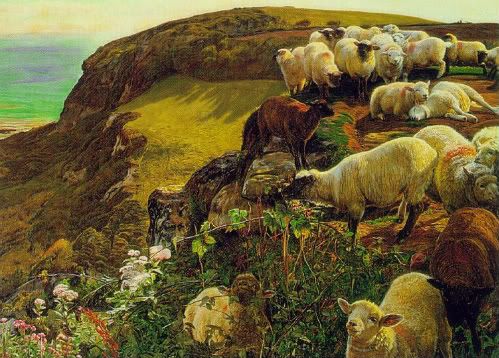
In the wake of the popularity of the The Hireling Shepherd, William Holman Hunt was asked by Charles T. Maud to paint another picture featuring the wayward sheep. In 1852, William Holman Hunt began work on Our English Coasts (also known as Strayed Sheep).
Hunt used the cliffs of Fairlight, east of Hastings, as the background for the work. You will recall that William the Conqueror, a Norman (French) invader, triumphed over the English forces at the battle of Hastings in 1066, forever changing the course of English history and introducing feudalism into England.
Hunt's choice of Hastings as the setting for his painting was certainly not a coincidence. Symbolism was so important to the Pre-Raphaelites that it seems very unlikely that Hunt would have chosen to portray a flock of "sheep" wandering precariously over the cliffs near Hastings if he hadn't intended to convey a deeper message. As a result, many have interpreted the painting as symbolic of fears of the French invading England. Interestingly, the Duke of Wellington, Arthur Wellesley, famed for his defeat of Napoleon at the Battle of Waterloo, died while Hunt was in the process of completing the painting.
The painting is also reminiscent of Alfred Lord Tennyson "Ode on the Death of the Duke of Wellington," especially these two lines:
Remember him who led your hosts;
He bade you guard the sacred coasts (VII, 21-22)
Whatever the deeper meaning behind the painting, it left a significant impression on art critic John Ruskin (who had defended Hunt's earlier work as well). When Our English Coasts was first exhibited, Ruskin praised the painting highly in his lecture series, The Art of England. Ruskin remarked that "it showed to us for the first time in the history of art, the absolutely faithful balances of colour and shade by which actual sunshine might be transposed into a key in which the harmonies possible with material pigments should yet produce the same impressions upon the mind which were caused by the light itself"(33.272-3).
As with Hunt's other early paintings, what is striking about this work is the near-photographic detail. The flowers and leaves in the background are done with incredible precision. Even the veins in the sheep's ears are lifelike! It's a really spectacular composition on so many levels. One of the things I really like about this painting is that it reminds us that the Pre-Raphaelites didn't just paint pictures of knights and ladies! There are so many beautiful landscapes done by artists in the Pre-Raphaelite vein that deserve more attention.
Tuesday, August 12, 2008
William Holman Hunt "Our English Coasts"
Posted by
Margaret
at
10:09 AM
![]()
![]()
Labels: pre-raphaelites, ruskin, william holman hunt
Subscribe to:
Post Comments (Atom)


5 comments:
I've never really liked a painting of sheep as much as this one!
My teeth feel super slippery! I usually wear my retainers that go over my teeth, so it's extra strange when I'm not wearing them.
Wait until you see Hunt's goat! He seems to have had quite a thing for farm animals, at least in comparison with the other Pre-Raphaelites. I'll be doing a post on "The Scapegoat" tomorrow.
I do think Hunt got tired of painting sheep after a while--they feature less prominently in his later paintings.
I can almost feel the sea wind on my face. I really adore this painting!
Lovely description Margaret. Such a variety of breeds in the painting. They have almost human expressions too. I did wonder about the mark of Cain in the red dye.
Yes the detailing is superb and so life like even in the vegetation- so accurate for the place.
The "French connection" is very possible. England at that time was very concerned about the supposed ambitions of Napoleon III, and there was a good deal of talk of war with France and possible invasion. A number of south coast fortifications were expanded because of it.
Post a Comment